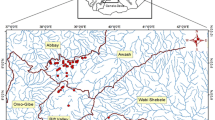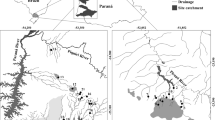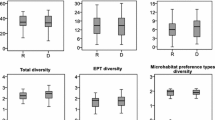Abstract
The Lachlan River system of inland New South Wales, which extends into semi-arid areas, is prone to natural extremes of climate and water quality and has been almost entirely modified since European settlement in Australia. We used this system as a proving ground for the mainly qualitative bioassessment metrics for river macroinvertebrates that are used widely in Australia – the EPT (Ephemeroptera, Plecoptera and Trichoptera) index, the SIGNAL (Stream Invertebrate Grade Number Average Level) biotic index and the AUSRIVAS O/E (Australian River Assessment System Observed over Expected) index – plus a recently developed qualitative index, the observed proportion of potential taxa (OPP). We tested these metrics on their ability to discriminate between sites judged to be less disturbed by human activities (reference sites) and sites selected by a semi-random process and therefore expected to have a higher average level of human disturbance (assessment sites). All metrics except the AUSRIVAS O/E index differed significantly between the two types of sites at higher altitudes, with SIGNAL showing the greatest discrimination. Assessment at these altitudes was more effective if based on composite data from multiple mesohabitats rather than data from single mesohabitats. No metric differentiated the two types of sites in the more arid, lowland, floodplain region of the river system. We suggest that Australia relies too heavily on bioassessment concepts developed to assess water pollution in well-watered regions of the Northern Hemisphere. Effective assessment of human impacts on macroinvertebrates in the rivers of inland Australia requires a better understanding of the roles of flow regimes, including flood and drought sequences, and of microhabitat structure and invasive alien species. Quantitative approaches may also be required.
Similar content being viewed by others
References
Arthington, A. H. and Pusey, B. J.: 2003, ‘Flow restoration and protection in Australian rivers’, River Research and Applications 19, 377–395.
Barmuta, L. A.: 2003, ‘Imperilled rivers of Australia: Challenges for assessment and conservation’, Aquatic Ecosystem Health and Management 6, 55–68.
Belbin, L.: 1991, ‘Semi-strong hybrid scaling, a new ordination algorithm’, Journal of Vegetation Science 2, 491–496.
Belbin, L.: 1994, PATN: Pattern Analysis Package Technical Reference, CSIRO Division of Wildlife and Ecology, Canberra, A.C.T., Australia.
Boulton, A. J.: 1999, ‘Why variable flows are needed for invertebrates of semi-arid rivers’, in: R. T. Kingsford (ed), A Free-Flowing River: The Ecology of the Paroo River, National Parks and Wildlife Service, Sydney, N.S.W., Australia, pp. 113–128.
Boulton, A. J.: 2003, ‘Parallels and contrasts in the effects of drought on stream macroinvertebrate assemblages’, Freshwater Biology 48, 1173–1185.
Boulton, A. J., Sheldon, F., Thoms M. C. and Stanley, E. H.: 2000, ‘Problems and constraints in managing rivers with variable flow regimes’, in: P. J. Boon, B. R. Davies and G. E. Petts (eds), Global Perspectives in River Conservation: Science, Policy and Practice, Wiley, Chichester, pp. 415–430.
Boulton, A. J. and Lake P. S.: 1992, ‘The ecology of two intermittent streams in Victoria, Australia. III. Temporary changes in faunal composition’, Freshwater Biology 27, 123–138.
Bowling, L. C. and Baker, P. D.: 1996, ‘Major cyanobacterial bloom in the Barwon-Darling River, Australia, in 1991, and underlying limnological conditions’, Marine and Freshwater Research 47, 643–657.
Cadwallader, P. L.: 1978, ‘Some causes of the decline in range and abundance of native fish in the Murray-Darling River system’, Proceedings of the Royal Society of Victoria 90, 211–224.
Chessman, B. C.: 1995, ‘Rapid assessment of rivers using macroinvertebrates: A procedure based on habitat-specific sampling, family-level identification, and a biotic index’, Australian Journal of Ecology 20, 122–129.
Chessman, B. C.: 2003, ‘New sensitivity grades for Australian river macroinvertebrates’, Marine and Freshwater Research 54, 95–103.
Chessman, B. C. and Royal, M. J.: 2004, ‘Bioassessment without reference sites: Use of environmental filters to predict natural assemblages of river macroinvertebrates’, Journal of the North American Benthological Society 23, 599–615.
Clarke, K. R.: 1993, ‘Non-parametric multivariate analyses of changes in community structure’, Australian Journal of Ecology 18, 117–143.
Clarke, R. T., Furse, M. T., Wright, J. F. and Moss, D.: 1996, ‘Derivation of a biological quality index for river sites: Comparison of the observed with the expected fauna’, Journal of Applied Statistics 23, 311–332.
Clarke, R. T., Wright, J. F. and Furse, M. T.: 2003, ‘RIVPACS models for predicting the expected macroinvertebrate fauna and assessing the ecological quality of rivers’, Ecological Modelling 160, 219–233.
Crabb, P.: 1995, Murray-Darling Basin Resources, Murray-Darling Basin Commission, Canberra, A.C.T., Australia.
Croke, B. F. W. and Jakeman, A. J.: 2001, ‘Predictions in catchment hydrology: An Australian perspective’, Marine and Freshwater Research 52, 65–79.
Davies, P. E.: 2000, ‘Development of a National River Bioassessment System (AUSRIVAS) in Australia’, in: J. F. Wright, D. W. Sutcliffe and M. T. Furse (eds), Assessing the Biological Quality of Fresh Waters: RIVPACS and Other Techniques, Freshwater Biological Association, Ambleside, U.K., pp. 113–124.
Department of Land and Water Conservation: 1998, Lachlan Catchment. State of the Rivers Report – 1997, NSW Government, Sydney, N.S.W., Australia.
Faragher, R. A. and Harris, J. H.: 1994, ‘The historical and current status of freshwater fish in New South Wales’, Australian Zoologist 29, 166–175.
Gippel, C. J., Finlayson, B. L. and O'Neill, I. C.: 1996, ‘Distribution and hydraulic significance of large woody debris in a lowland Australian river’, Hydrobiologia 318, 179–194.
Growns, J. E., Chessman, B. C., Jackson, J. E. and Ross, D. G.: 1997, ‘Rapid assessment of Australian rivers using macroinvertebrates: Cost and efficiency of six methods of sample processing’, Journal of the North American Benthological Society 16, 682–693.
Growns, J. E., Chessman, B. C., McEvoy, P. K. and Wright, I. A.: 1995, ‘Rapid assessment of rivers using macroinvertebrates: Case studies in the Nepean River and Blue Mountains, NSW’, Australian Journal of Ecology 20, 130–141.
Growns, J. E., King, A. J. and Betts, F. M.: 1999, ‘The snag bag: A new method for sampling macroinvertebrate communities on large woody debris’, Hydrobiologia 405, 67–77.
Hawkes, H. A.: 1997, ‘Origin and development of the Biological Monitoring Working Party Score System’, Water Research 32, 964–968.
Humphries, P., Growns, J. E., Serafini, L. G., Hawking, J. H., Chick, A. J. and Lake, P. S.: 1998, ‘Macroinvertebrate sampling methods for lowland Australian rivers’, Hydrobiologia 364, 209–218.
Jansen, A. and Robertson, A. I.: 2001, ‘Relationships between livestock management and the ecological condition of riparian habitats along an Australian floodplain river’, Journal of Applied Ecology 38, 63–75.
Jolly, I. D., Williamson, D. R., Gilfedder, M., Walker, G. R., Morton, R., Robinson, G., Jones, H., Zhang, L., Dowling, T. I., Dyce, P., Nathan, R. J., Nandakumar, N., Clarke, R. and McNeill, V.: 2001, ‘Historical stream salinity trends and catchment salt balances in the Murray-Darling Basin, Australia’, Marine and Freshwater Research 52, 53–63.
Kingsford, R. T.: 1995, ‘Ecological effects of river management in New South Wales’, in: R. A. Bradstock, T. D. Auld, D. A. Keith, R. T. Kingsford, D. Lunney and D. P. Sivertsen (eds), Conserving Biodiversity: Threats and Solutions, Surrey Beatty and Sons, Chipping Norton, N.S.W., Australia, pp. 144–161.
Kingsford, R. T.: 2000a, ‘Ecological impacts of dams, water diversions and river management on floodplain wetlands in Australia’, Austral Ecology 25, 109–127.
Kingsford, R. T.: 2000b, ‘Protecting rivers in arid regions or pumping them dry?’, Hydrobiologia 427, 1–11.
Lake, P. S.: 1995, ‘Of droughts and floods: River and stream ecosystems of Australia’, in: C. E. Cushing, K. W. Cummins and G. W. Minshall (eds), River and Stream Ecosystems, Elsevier, Amsterdam, Holland, pp. 659–694.
Lenat, D. R.: 1988, ‘Water quality assessment of streams using a qualitative collection method for benthic macroinvertebrates’, Journal of the North American Benthological Society 7, 222-233.
Marchant, R., Hirst, A., Norris, R. H., Butcher, R., Metzeling, L. and Tiller, D.: 1997, ‘Classification and prediction of macroinvertebrate assemblages from running waters in Victoria, Australia’, Journal of the North American Benthological Society 16, 664–681.
Marohasy, J.: 2003, Myth and the Murray. Measuring the Real State of the River Environment, Institute of Public Affairs, Melbourne, Victoria, Australia.
McCune, B. and Mefford, M. J.: 1999, PC-ORD. Multivariate Analysis of Ecological Data, Version 4, MJM Software Design, Gleneden Beach, Oregon, U.S.A.
McMahon, T. A. and Finlayson B. L.: 2003, ‘Droughts and anti-droughts: The low-flow hydrology of Australian rivers’, Freshwater Biology 48, 1147–1160.
Metzeling, L., Chessman, B., Hardwick, R. and Wong, V.: 2003, ‘Rapid assessment of rivers using macroinvertebrates: The role of experience, and comparisons with quantitative methods’, Hydrobiologia 510, 39–52.
Metzeling, L., Robinson, D., Perriss, S. and Marchant, R.: 2002, ‘Temporal persistence of benthic invertebrate communities in south-eastern Australian streams: Taxonomic resolution and implications for the use of predictive models’, Marine and Freshwater Research 53, 1223-1234.
Mitchell, T. L.: 1839, Three Expeditions into the Interior of Eastern Australia; with Descriptions of the Recently Explored Region of Australia Felix, and of the Present Colony of New South Wales, 2nd edition, T. and W. Boone, London, U.K.
Murray-Darling Basin Ministerial Council: 1987, Murray-Darling Basin Environmental Resources Study, State Pollution Control Commission, Sydney, N.S.W., Australia.
O'Connor, N. A.: 1991, ‘The effects of habitat complexity on the macroinvertebrates colonising wood substrata in a lowland stream’, Oecologia 85, 504–512.
Oxley, J.: 1820, Journals of Two Expeditions into the Interior of New South Wales, Undertaken by Order of the British Government in the Years 1817–1818, John Murray, London, U.K.
Parsons, M. and Norris, R. H.: 1996, ‘The effect of habitat-specific sampling on biological assessment of water quality using predictive models’, Freshwater Biology 36, 419–434.
Penrose, D. L., Lenat, D. R. and Eagleson, K. W.: 1980, ‘Biological Evaluation of Water Quality in North Carolina Streams and Rivers’, Biological Series, 103, NC Division of Environmental Management, Raleigh, North Carolina, U.S.A.
Preece, R. M. and Jones, H. A.: 2002, ‘The effect of Keepit Dam on the temperature regime of the Namoi River, Australia’, River Research and Applications 18, 397–414.
Puckridge, J. T., Sheldon, F., Walker, K. F. and Boulton, A. J.: 1998, ‘Flow variability and the ecology of large rivers’, Marine and Freshwater Research 49, 55–72.
Roberts, J.: 2002, ‘Species-level knowledge of riverine and riparian plants: A constraint for determining flow requirements in the future’, Australian Journal of Water Resources 5, 21–31.
Roberts, J. and Sainty, G.: 1996, Listening to the Lachlan, Sainty and Associates Pty Ltd, Sydney, N.S.W., Australia.
Schumm, S. A.: 1977, The Fluvial System, Wiley, New York, New York, U.S.A.
Shearer, K. D. and Mulley, J. C.: 1978, ‘The introduction and distribution of the carp, Cyprinus carpio Linnaeus, in Australia’, Australian Journal of Marine and Freshwater Research 29, 551–563.
Sheldon, F. and Walker, K. F.: 1998, ‘Spatial distribution of littoral invertebrates in the lower Murray-Darling River system, Australia’, Marine and Freshwater Research 49, 171–182.
Simpson, J. C. and Norris, R. H.: 2000, ‘Biological assessment of river quality: Development of AUSRIVAS models and outputs’, in: J. F. Wright, D. W. Sutcliffe and M. T. Furse (eds), Assessing the Biological Quality of Fresh Waters: RIVPACS and Other Techniques, Freshwater Biological Association, Ambleside, U.K., pp. 125–142.
Sloane, P. I. W. and Norris, R. H.: 2003, ‘Relationship of AUSRIVAS- based macroinvertebrate predictive model outputs to a metal pollution gradient’, Journal of the North American Benthological Society 22, 457–471.
Sloane, P., Simpson, J. and Norris, R.: 1997, ‘ACT component of the Monitoring River Health Initiative’, Final Report, 2, Cooperative Research Centre for Freshwater Ecology, Canberra, A.C.T., Australia.
Smith, M. J., Kay, W. R., Edward, D. H. D., Papas, P. J., Richardson, K. St J., Simpson, J. C., Pinder, A. M., Cale, D. J., Horwitz, P. H. J., Davis, J. A., Yung, F. H., Norris, R. H. and Halse, S. A.: 1999, ‘AusRivAS: Using macroinvertebrates to assess ecological conditions of rivers in Western Australia’, Freshwater Biology 41, 269–282.
Sturt, C.: 1833, Two Expeditions into the Interior of Southern Australia, During the Years 1828, 1829, 1830, and 1832: with Observations on the Soil, Climate, and General Resources of the Colony of New South Wales, Smith, Elder and Company, London, U.K.
Thoms, M. C., Ogden, R. W. and Reid, M. A.: 1999, ‘Establishing the condition of lowland floodplain rivers: a palaeo-ecological approach’, Freshwater Biology 41, 407–423.
Thoms, M. C. and Sheldon, F.: 2000, ‘Lowland rivers: An Australian introduction’, Regulated Rivers: Research and Management 16, 375–383.
Turak, E., Flack, L. K., Norris, R. H., Simpson, J. and Waddell, N.: 1999, ‘Assessment of river condition at a large spatial scale using predictive models’, Freshwater Biology 41, 283–298.
Turak, E. and Waddell, N.: 2001, New South Wales (NSW) Australian River Assessment System (AUSRIVAS) Sampling and Processing Manual, Environment Protection Authority, Sydney, N.S.W., Australia.
Vannote, R. L., Minshall, G. W., Cummins, K. W., Sedell, J. R. and Cushing, C. E.: 1980, ‘The river continuum concept’, Canadian Journal of Fisheries and Aquatic Sciences 37, 130–137.
Walker, K. F., Sheldon, F. and Puckridge, J. T.: 1995, ‘A perspective on dryland river ecosystems’, Regulated Rivers: Research and Management 11, 85–104.
Whittington, J., Coysh, J., Davies, P., Dyer, F., Gawne, B., Lawrence, I., Liston, P., Norris, R., Robinson, W. and Thoms, M.: 2001, ‘Development of a Framework for the Sustainable Rivers Audit. A Report to the Murray Darling Basin Commission, Technical Report, 8/2001, Cooperative Research Centre for Freshwater Ecology, Canberra, A.C.T., Australia. http://enterprise.canberra.edu.au/Publications.nsf/0/f52fb94d8e5d2a20ca256f0f0014b431?OpenDocument
Wilkinson, L.: 1990, SYSTAT: The System for Statistics. SYSTAT, Inc., Evanston, Illinois.
Young, W. (ed): 2001, Rivers as Ecological Systems: The Murray-Darling Basin, Murray-Darling Basin Commission, Canberra, A.C.T., Australia.
Author information
Authors and Affiliations
Corresponding author
Rights and permissions
About this article
Cite this article
Chessman, B.C., Thurtell, L.A. & Royal, M.J. Bioassessment in A Harsh Environment: A Comparison of Macroinvertebrate Assemblages at Reference and Assessment Sites in An Australian Inland River System. Environ Monit Assess 119, 303–330 (2006). https://doi.org/10.1007/s10661-005-9027-2
Received:
Accepted:
Published:
Issue Date:
DOI: https://doi.org/10.1007/s10661-005-9027-2




